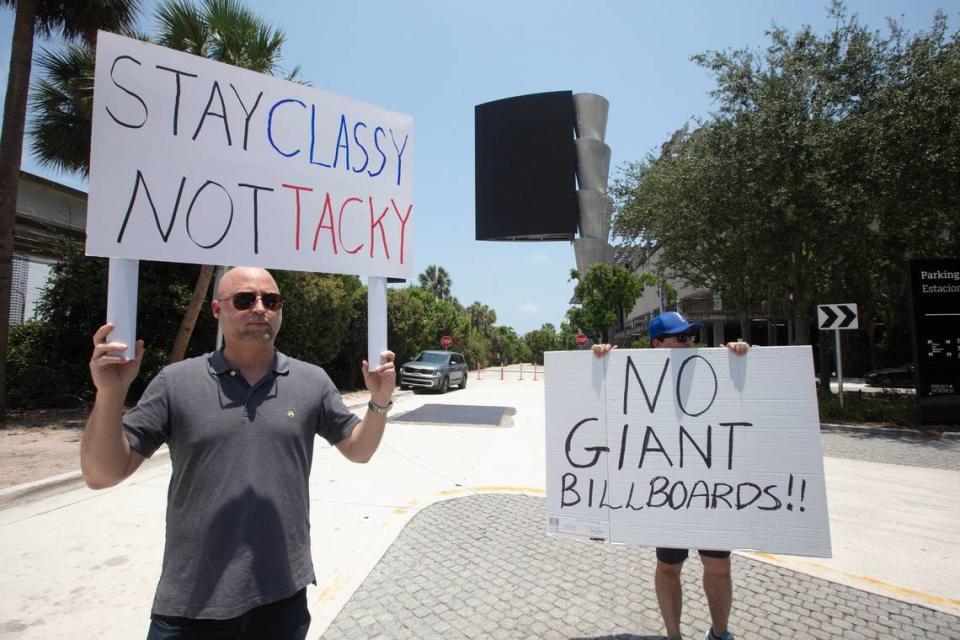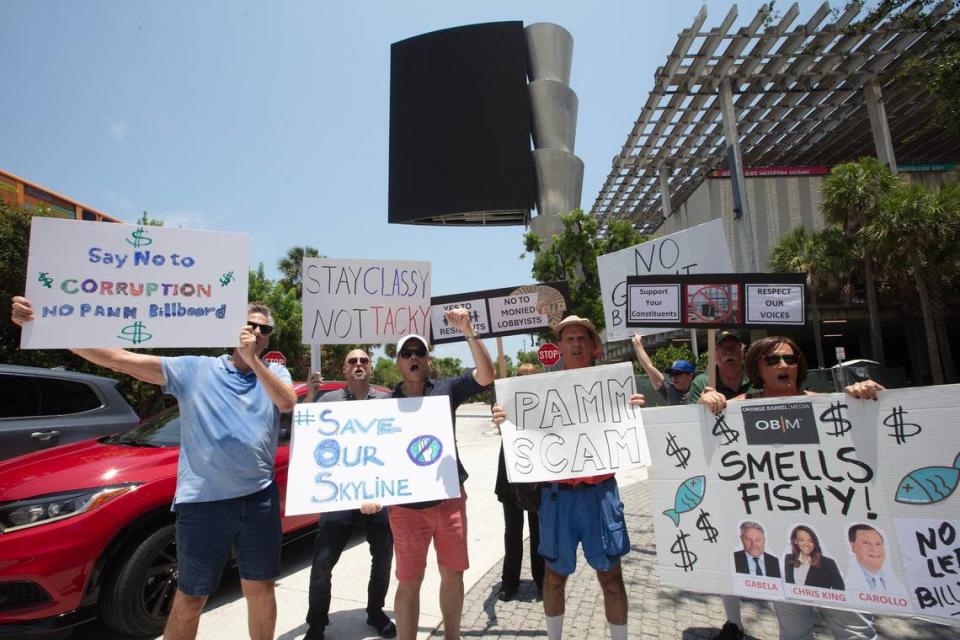After repealing sign law, Miami wants court fight over art museum’s digital billboard
Miami may seek demolition of an art museum’s jumbo digital billboard after city commissioners voted Thursday to repeal the law that allowed its construction.
For now, the Pérez Art Museum of Miami’s jumbo digital billboard remains in compliance with city regulations because it already received a Miami permit under the legislation that passed in 2023 and more than doubled the size allowed for advertising signs in a few areas downtown.
Commissioners voted 4-1 to repeal that law but agreed that removing the ordinance from Miami’s code wouldn’t force PAMM to remove the existing sign. The lone no vote came from Commissioner Manolo Reyes.
“We can’t revoke a permit,” said Commissioner Damian Pardo, who was elected in November and soon after launched the effort to repeal the 2023 law that allowed PAMM to construct its 1,800-foot digital billboard earlier this year.
READ MORE: There’s a supersized digital billboard rising downtown. Will Miami make it illegal?
But the Pardo legislation given final approval Thursday evening opens a new risk for the PAMM billboard, with instructions to Miami lawyers to determine whether the museum violated a city lease in building the advertising structure itself.
PAMM is a nonprofit museum that leases its waterfront land from Miami, and it’s on that public property where the billboard structure stands. Pardo said the museum did not seek proper permission from its landlord — the Miami government — to authorize construction on the city-owned land, putting it in default.
“There is a path to bring down the PAMM sign through our lease,” said Pardo, whose district includes the Miami waterfront where high-rise residents condemned the 1,800-square-foot billboard as a bright blight on their views. “It should come down. That is what residents are demanding.”
On Thursday night, a PAMM spokesperson said the museum could not address the specifics of the alleged lease violations raised at the commission meeting because it has not received any paperwork from Miami. But the spokesperson said PAMM followed the rules governing its city land.
“We have not received a default notice, so we cannot speak to the specifics of the notice,” said Alexa Ferra, PAMM’s communications director. “However, we are in full compliance with our lease and have followed every obligation required under our agreement.”
The PAMM sign was authorized twice by Miami. City commissioners named the museum in the 2023 law allowing the larger billboards in a few downtown locations, including Bayfront Park and the Adrienne Arsht Center for the Performing Arts. The city’s Building Department also issued PAMM a billboard permit ahead of construction beginning.
Under the Pardo legislation, the fate of the sign now rests on whether a third government approval was also needed.
Commissioners voted to seek a ruling by a judge that Miami’s ground lease with PAMM gives the city authority over the museum’s contract with Ohio’s Orange Barrel Media to build the digital billboard off Interstate 395 that’s expected to generate millions of dollars in advertising a year.
Reyes opposed passing legislation that on the face of it allows the PAMM billboard to remain standing.
While the rules authorizing the jumbo digital billboard were stripped from the city code under the new legislation, the PAMM sign will be considered a legal “non-conforming” structure, a city lawyer said.
“My vote is a protest,” Reyes said.

Thursday’s vote shifts the fight over the PAMM billboard to the court system after months of debate over repealing the 2023 law sponsored by then-Commissioner Alex Díaz de la Portilla, who was later arrested on bribery charges.
“My predecessor, who is under indictment charges at the moment, created this mess,” said Commissioner Miguel Gabela, who defeated Díaz de la Portilla in November while the incumbent was suspended from office after his September arrest. “The gentleman ruled this dais with an iron fist.”
Orange Barrel Media, the billboard company behind the PAMM sign, gave $225,000 that helped bankroll Diaz de la Portilla’s failed reelection effort in the months after his expanded digital-sign rules passed the commission in January 2023.
Pardo introduced repeal legislation at the start of 2024, but the issue was divisive and a final vote was delayed through five prior meetings before the final vote shortly before 6:30 p.m. Thursday.
As they had in prior meetings, PAMM supporters urged commissioners Thursday to support cultural institutions and let the museum promote art with the new sign off I-395. “The billboard serves as a platform for our community,” said Pedro Amos, an advocate for public art in Miami. “I don’t see a big issue with this. I actually see many pros.”
Residents of downtown apartment buildings claimed their quality of life was being sacrificed for advertising dollars.
“I want to let you know just how upset downtown [residents] are about these signs,” Kristen Browde, who owns a condo in a high-rise a few blocks from PAMM, told commissioners. “We want to support the arts, but we don’t want to destroy our neighborhood.”

Miami’s billboard fight also pitted PAMM against its neighbor, the Frost Museum of Science, which has a rooftop deck it rents out for events that sits under the new sign. PAMM pitched the billboard as a vital source of new revenue for the tax-funded museum, while Frost claimed light pollution would diminish visitors’ experience.
The original 2023 law allowed 1,800-square-foot digital billboards — more than twice the existing 750-square-foot limit elsewhere in Miami and throughout the county — for both PAMM and the nearby Adrienne Arsht Center for the Performing Arts.
While Orange Barrel launched construction quickly at the PAMM site after securing city permits, the two 10-story billboards at Arsht never got past the approval stage.
Now those potential billboards are caught up in a dispute between Miami and Miami-Dade County, which owns the Arsht Center and allows a nonprofit organization to run the facility.
Earlier this month, the county’s mayor, Daniella Levine Cava, instructed Arsht management to withdraw its city permit for the billboards and seek county permission to build them. Arsht’s leadership agreed the next day, likely leaving the fate of that nonprofit’s billboards in the hands of the 13-member County Commission.
Though Thursday’s legislation repeals the original Díaz de la Portilla ordinance, it also includes new restrictions that apply to signs that were authorized in 2023.
Those new rules include brightness limits and an 11 p.m. shutdown requirement on most days for digital signs considered non-conforming structures. They apply to the PAMM billboard, along with three smaller digital signs that were permitted in Bayfront Park.
Nighttime light was a top complaint of residents fighting both the existing PAMM sign and the pair of billboards planned for Arsht.
“We pay a lot of money. We pay a lot of property taxes for where we live,” said Sharon Kirby, a resident on the Venetian Causeway that connects Miami Beach with the city. “We do not need this visual pollution looking back at us when we look at downtown Miami.”
This article was updated to correct the name of Sharon Kirby, who spoke at the May 23 meeting of the Miami City Commission.

